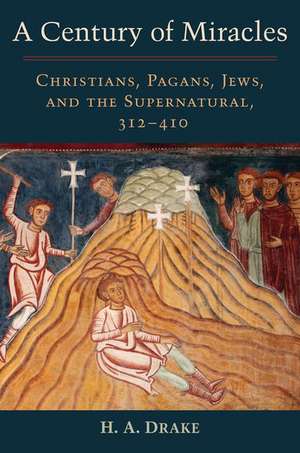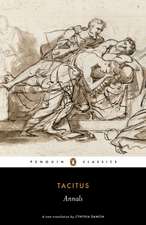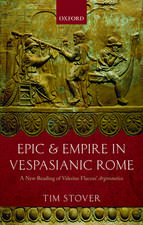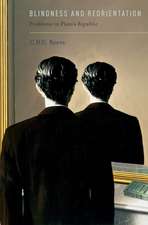A Century of Miracles: Christians, Pagans, Jews, and the Supernatural, 312-410
Autor H. A. Drakeen Limba Engleză Hardback – 26 oct 2017
Preț: 282.24 lei
Preț vechi: 296.84 lei
-5% Nou
Puncte Express: 423
Preț estimativ în valută:
54.01€ • 56.18$ • 44.59£
54.01€ • 56.18$ • 44.59£
Carte tipărită la comandă
Livrare economică 03-09 aprilie
Preluare comenzi: 021 569.72.76
Specificații
ISBN-13: 9780199367412
ISBN-10: 0199367418
Pagini: 328
Ilustrații: 27 b&w halftones/line art
Dimensiuni: 147 x 211 x 18 mm
Greutate: 0.5 kg
Editura: Oxford University Press
Colecția OUP USA
Locul publicării:New York, United States
ISBN-10: 0199367418
Pagini: 328
Ilustrații: 27 b&w halftones/line art
Dimensiuni: 147 x 211 x 18 mm
Greutate: 0.5 kg
Editura: Oxford University Press
Colecția OUP USA
Locul publicării:New York, United States
Recenzii
This is an engaging study in how history is narrativised. The assumptions that Drake draws and frameworks that he establishes make for an enlightening read... This page-turner reads like a serialised novel on the real schemers and scoundrels of the late Roman Empire, written by a seasoned scholar well-versed in the ancient source material and scholarly landscape. Drake's good humour and varied, supporting references (for example, movies, material culture) will interest a wide audience... the relevance of this monograph extends far beyond the century of miracles.
A Century of Miracles is a pleasant read. Drake knows how to combine scholarly discussion with an accessible and at times punchy style ... and lively comparisons are made with modern issues. The miracle stories are contextualised with late antique history in general, discussions ranging from the relations between emperors and bishops; questioning the dichotomies of pagans and Christians; the problem of the Constantinian turn; the debates on Julian's School Law, and so on.
this is an entertaining and interesting journey through a century of miracles which sheds a new perspective on their individual significance and on the role they played in the spread of C241Christianity and in its endurance through later centuries.
[this book] gives an insightful and engaging account of the development of Christian ideology across the fourth century, and is probably all the better for sidelining the doctrinal controversies that might otherwise bog down the narrative. There are plentiful insights and neat turns of phrase, and helpful illustrations including a stunning photograph (sourced from Wikimedia Commons) of a real solar halo. Drake tells his stories with a touch of humour, and he is quite right not to believe them.
Drake succeeds in demonstrating how these miracle stories reassured Christians that God wanted to make Christianity the official religion of the Roman Empire. The author writes objectively, and while stating his intention in writing, he is not biased nor demonstrates an agenda to build a case for the miraculous. That is evident when he meticulously and critically examines the evidence purporting such happenings.
Drake's treatment is a humorous, learned and delightful romp that provides for long-embattled questions within the field answers that are intelligible, coherent and enjoyable to engage ... It is a valuable read for any student of 4th-century Christianity and a requisite one for any scholars working on the issues Drake covers.
Throughout, Drake proves himself to be a most congenial guide to the late antique miraculous, pointing out the highlights and inconsistencies, and always helping the reader understand how such apparently implausible stories came to exercise so profound an influence over the historical imagination from the 4th century down to our own day.
Summing Up: Recommended. Upper-division undergraduates through faculty; general readers.
In this masterly book, Drake takes us on a roller-coaster ride through the last century of the Roman Empire. From Constantine's conversion onwards, a series of breathtaking military victories and similar stunning events seemed to prove that the empire was directly favored by the Christian God. Then the ride ended with a spectacular jolt. In 410 the Goths sacked Rome. Only Augustine's City of God could make sense of the end of an age of public euphoria. For those who wish to capture the feel of Rome in its last days -- and especially the poignant hopes of those who believed that Christianity might make Rome great again -- this book is a must.
Drake traces how in the fourth century, Roman emperors and their families, bishops, and ascetics all appealed to miracles to foster their agendas as well as the Empire's Christianization. A lively, accessible account of an important century by a master historian of the Constantinian era.
With keen insight and indomitable good humor, Drake investigates the tumultuous period between Constantine ('the emperor who opened the door to Christianity') and Theodosius ('the one who slammed it shut on everybody else'). What factors fed the rise of the church? Christians, he urges, learned how to meaningfully -- and strategically -- narrate miracles. A pleasure to think with and a joy to read, A Century of Miracles belongs in your hands and on your bookshelf. Tolle, lege!
A Century of Miracles is a pleasant read. Drake knows how to combine scholarly discussion with an accessible and at times punchy style ... and lively comparisons are made with modern issues. The miracle stories are contextualised with late antique history in general, discussions ranging from the relations between emperors and bishops; questioning the dichotomies of pagans and Christians; the problem of the Constantinian turn; the debates on Julian's School Law, and so on.
this is an entertaining and interesting journey through a century of miracles which sheds a new perspective on their individual significance and on the role they played in the spread of C241Christianity and in its endurance through later centuries.
[this book] gives an insightful and engaging account of the development of Christian ideology across the fourth century, and is probably all the better for sidelining the doctrinal controversies that might otherwise bog down the narrative. There are plentiful insights and neat turns of phrase, and helpful illustrations including a stunning photograph (sourced from Wikimedia Commons) of a real solar halo. Drake tells his stories with a touch of humour, and he is quite right not to believe them.
Drake succeeds in demonstrating how these miracle stories reassured Christians that God wanted to make Christianity the official religion of the Roman Empire. The author writes objectively, and while stating his intention in writing, he is not biased nor demonstrates an agenda to build a case for the miraculous. That is evident when he meticulously and critically examines the evidence purporting such happenings.
Drake's treatment is a humorous, learned and delightful romp that provides for long-embattled questions within the field answers that are intelligible, coherent and enjoyable to engage ... It is a valuable read for any student of 4th-century Christianity and a requisite one for any scholars working on the issues Drake covers.
Throughout, Drake proves himself to be a most congenial guide to the late antique miraculous, pointing out the highlights and inconsistencies, and always helping the reader understand how such apparently implausible stories came to exercise so profound an influence over the historical imagination from the 4th century down to our own day.
Summing Up: Recommended. Upper-division undergraduates through faculty; general readers.
In this masterly book, Drake takes us on a roller-coaster ride through the last century of the Roman Empire. From Constantine's conversion onwards, a series of breathtaking military victories and similar stunning events seemed to prove that the empire was directly favored by the Christian God. Then the ride ended with a spectacular jolt. In 410 the Goths sacked Rome. Only Augustine's City of God could make sense of the end of an age of public euphoria. For those who wish to capture the feel of Rome in its last days -- and especially the poignant hopes of those who believed that Christianity might make Rome great again -- this book is a must.
Drake traces how in the fourth century, Roman emperors and their families, bishops, and ascetics all appealed to miracles to foster their agendas as well as the Empire's Christianization. A lively, accessible account of an important century by a master historian of the Constantinian era.
With keen insight and indomitable good humor, Drake investigates the tumultuous period between Constantine ('the emperor who opened the door to Christianity') and Theodosius ('the one who slammed it shut on everybody else'). What factors fed the rise of the church? Christians, he urges, learned how to meaningfully -- and strategically -- narrate miracles. A pleasure to think with and a joy to read, A Century of Miracles belongs in your hands and on your bookshelf. Tolle, lege!
Notă biografică
H. A. Drake is Research Professor of History at the University of California, Santa Barbara, and the author of Constantine and the Bishops.












